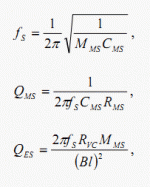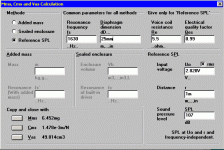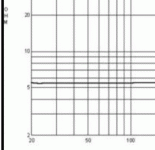I was intrigued by sannax's wishing to try & design a horn http://www.diyaudio.com/forums/subwoofers/119854-hornresp-238.html for which only a limited amount of data is published. dirkwright uploaded specs for the B&C DE10 namely -
I downloaded the PDF & from looking at the fr/impedence graph i initially estimated fs @ around 1800 Hz to start working with.
I had an intuitive feeling it "might" be possible to determine more data by experimenting with one or more design programes 😉 Well to my great surprise & joy, i was able to deduce a lot more info than i initially hoped for 🙂 Using a combination of Horn Response & WinISD i came up with the following.
fs = 1907 Hz
Qes = 0.99
Qms = 0.1
Qts = 0.091
Vas = 0.05 L
Rms = 4.1
Sd = 13 cm2
Cms = 0.0002075 m/N
Mmd = 0.1 gm
BL = 1.6 Tm
Dd = 0.041 m
A few of the numbers were in slight disagreement between programs, but Not far too off to make much of a difference IMO.
Vd & Mms were elusive, but wouldn't prevent a design taking place. I "presume" these could be back engineered from some of the other data ?
From my above tests, it seems that this method of estabilsing data is not restricted to Bass/Mid drivers, but across the full range 🙂
Hopefully some of you might be encouraged to try it for yourselves with the same driver, and/or others, & post your findings 🙂
Throat Diameter 25 mm (1 in)
Nominal Impedance 8 ohm
Minimum Impedance 6.3 ohm
Nominal Power Handling (AES) 20 W
Sensitivity (1W/1m) 107 dB
Frequency Range 1.5 - 18 kHz
Recommended Crossover 2.5 kHz
Voice Coil Diameter 25 mm (1 in)
Inductance 0.1 mH
Flux Density 1.55 T
I downloaded the PDF & from looking at the fr/impedence graph i initially estimated fs @ around 1800 Hz to start working with.
I had an intuitive feeling it "might" be possible to determine more data by experimenting with one or more design programes 😉 Well to my great surprise & joy, i was able to deduce a lot more info than i initially hoped for 🙂 Using a combination of Horn Response & WinISD i came up with the following.
fs = 1907 Hz
Qes = 0.99
Qms = 0.1
Qts = 0.091
Vas = 0.05 L
Rms = 4.1
Sd = 13 cm2
Cms = 0.0002075 m/N
Mmd = 0.1 gm
BL = 1.6 Tm
Dd = 0.041 m
A few of the numbers were in slight disagreement between programs, but Not far too off to make much of a difference IMO.
Vd & Mms were elusive, but wouldn't prevent a design taking place. I "presume" these could be back engineered from some of the other data ?
From my above tests, it seems that this method of estabilsing data is not restricted to Bass/Mid drivers, but across the full range 🙂
Hopefully some of you might be encouraged to try it for yourselves with the same driver, and/or others, & post your findings 🙂



